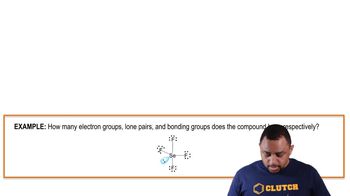Here are the essential concepts you must grasp in order to answer the question correctly.
VSEPR Theory
Valence Shell Electron Pair Repulsion (VSEPR) Theory is a model used to predict the geometry of individual molecules based on the repulsion between electron pairs in the valence shell of the central atom. According to VSEPR, electron pairs, including lone pairs, will arrange themselves to minimize repulsion, leading to specific molecular shapes such as linear, trigonal planar, tetrahedral, and octahedral.
Recommended video:
Molecular Shapes and VSEPR
Lone Pairs and Bonding Pairs
In molecular geometry, lone pairs are pairs of valence electrons that are not involved in bonding, while bonding pairs are shared between atoms. Lone pairs occupy more space than bonding pairs, affecting the overall shape of the molecule. Understanding the distinction between these pairs is crucial for accurately predicting molecular geometry using VSEPR Theory.
Recommended video:
Electron Groups, Lone Pairs, and Bonding Groups Example
Hybridization
Hybridization is the concept of mixing atomic orbitals to form new hybrid orbitals that can accommodate the bonding and lone pairs in a molecule. This process helps explain the geometry of molecules by determining the types of bonds formed and the angles between them. For example, sp3 hybridization leads to tetrahedral shapes, while sp2 results in trigonal planar arrangements.
Recommended video:
 Verified step by step guidance
Verified step by step guidance

